Overview: Large language models
While this overview will eventually reflect everything tagged #llm on this Hub, my current focus is on how LLMs could best support MyHub users in particular and inhabitants of decentralised collective intelligence ecosystems in general (cf. How Artificial Intelligence will finance Collective Intelligence). This is version 1.x, 2023-04-24.
How the hell does this work?
The best explanation of how it works by far comes from Jon Stokes' ChatGPT Explained: A Normie's Guide To How It Works. In essence, "each possible blob of text the model could generate ... is a single point in a probability distribution". So when you Submit a question, you're collapsing the wave function and landing on a point in that probability distribution: a collection of symbols probably related to what you inputted. That collection's content depends "on the shape of the probability distributions ... and on the dice that the ... computer’s random number generator is rolling."
So if you ask whether Schrodinger's Cat is alive or dead, you'll get different answers depending on how you ask the question not because the LLM understands anything about Schrodinger, his cat or quantum mechanics, but because amongst all "possible collections of symbols the model could produce... there are regions in the model’s probability distributions that contain collections of symbols we humans interpret to mean that the cat is alive. And ... adjacent regions ... containing collections of symbols we interpret to mean the cat is dead. ChatGPT’s latent space has been deliberately sculpted into a particular shape by...":
- Training "a foundation model on high-quality data" so it's "like an atom where the orbitals are shaped in a way we find to be useful.
- Fine-tuning "it with more focused, carefully curated training data" to reshape problematic results
- Reinforcement learning with human feedback (RLHF) to further refine the "model’s probability space so that it covers as tightly as possible only the points ... that correspond to “true facts” (whatever those are!)"
The key takeaway here is that ChatGPT is not truly talking to you, it's "just shouting language-like symbol collections into the void". And here's a good example of its spectacularly wrong hallucinations.
What the hell does it mean?
As such it is not "almost AI", it's not even close. According to Noam Chomsky, "The human mind is not... a lumbering statistical engine for pattern matching... True intelligence is demonstrated in the ability to think and express improbable but insightful things.... [and is] also capable of moral thinking", whereas ChatGPT's "moral indifference born of unintelligence... exhibits something like the banality of evil: plagiarism and apathy and obviation", summarising arguments but refusing to take a position because its creators learnt their lesson with Taybot.
Not understanding this is dangerous, as the interview/profile of Emily M. Bender in You Are Not a Parrot And a chatbot is not a human makes clear: "LLMs are great at mimicry and bad at facts... the Platonic ideal of the bullshitter... don’t care whether something is true or false... only about rhetorical power. [So] do not conflate word form and meaning. Mind your own credulity... [we've made] machines that can mindlessly generate text... we haven’t learned how to stop imagining the mind behind it."
Believing an LLM understands what it says is particularly a problem given that it was trained on words written overwhelmingly by white people, with men and wealth overrepresented (see also OpenAI’s ChatGPT Bot Recreates Racial Profiling). Bender is very good on what the safe use of artificial intelligence looks like (TL:DR; ChatGPT ain't it), covering the dehumanising effect of treating LLMs like humans, and humans like LLMs, and asking what happens when we habituate "people to treat things that seem like people as if they’re not”? Won't we all start treating real humans worse?
Answer: we might "lose a firm boundary around the idea that humans... are equally worthy", bordering on fascism: "The AI dream is governed by the perfectibility thesis... a fascist form of the human."
For more on why we must avoid a tiny number of companies dominating the field:
- "We are now facing the prospect of a significant advance in AI using methods that are not described in the scientific literature and with datasets restricted to a company that appears to be open only in name… And if history is anything to go by, we know a lack of transparency is a trigger for bad behaviour in tech spaces” - Everyone’s having a field day with ChatGPT — but nobody knows how it actually works
- "The claims re: ChatGPT by "fascinated evangelists" are simply "a distraction from the actual harm perpetuated by these systems. People get hurt from the very practical ways such models fall short in deployment", while its achievements are presented as independent of its engineers' choices, disconnecting them from human accountability - ChatGPT, Galactica, and the Progress Trap.
How can I use it?
Understanding how it does what it does is key to understanding the answer to this question, so Stokes' Normie's Guide, above, is also good here: "Isn’t the model’s ability to make things up often a feature, not a bug?".
More practically:
- in The Mechanical Professor Ethan Mollick, uni professor, puts ChatGPT through its paces. From my notes: impressive as a teacher, not great as a researcher/academic writer ("Nothing particularly wrong, but also nothing good"), reasonable summariser and general writer ("results were not brilliant, and I wouldn’t vouch for their accuracy"). So while not yet a threat to real academics, ChatGPT is a jobkiller for copywriters, almost everyone on New Grub Street and anyone else spending their days churning out rehashed content.
- learn something: give it a summary of something (or ask it so summarise, but then doublecheck for hallucinations), and then ask it to ask you questions about it and rate your answers. But doublecheck for hallucinations...
Prompt engineering
My reading queue is overflowing with identikit posts on prompt engineering, which I'll get to eventually.
AutoGPT: adding value to LLMs to create focused AI assistants
"AutoGPTs... automate multi-step projects that would otherwise require back-and-forth interactions with GPT-4... enable the chaining of thoughts to accomplish a specified objective and do so autonomously" - something I've already played with in the shape of AgentGTP, and which encapsulates how I'll integrate this into MyHub.ai (next), because this approach "transforms chat from a basic communication tool into ... AI into assistants working for you".
How should it be integrated into MyHub?
How could these LLMs be integrated into tools for thought in general, and (tomorrow's) MyHub.ai in particular? I've always wanted to access AI services from inside the MyHub thinking tool (see Thinking and writing in a decentralised collective intelligence ecosystem), from where it can apply its abilities to one's own notes. But what will that look like?
My first thought: "imagine your own personal AI assistant operating across your content - your public posts, private library (including content shared from friends, stuff in your reading queue, etc.) and the wider web, emphasising the sources you favour (based firstly on your Priority Sources, and then on the number of times you've curated their content)."
In I Built an AI Chatbot Based On My Favorite Podcast, the author shows how to do just that: "It took probably a weekend of effort" to build a chatbot to search his library "of all transcripts from the Huberman Lab podcasts, finds relevant sections and send them to GPT-3 with a carefully designed prompt".
A step-by-step guide to building a chatbot based on your own documents with GPT goes into far more detail.
Pretty soon I'll be able to do something similar, playing with ChatGPT combined with my entire Hub of over 3600 pieces of content. But while the above chatbot answers questions, I'm already pretty sure I don't want to treat ChatGPT like a search engine.
Instead, going into this experiment, ChatGPT as muse, not oracle is my overall starting point, asking "What if we were to think of LLMs not as tools for answering questions, but as tools for asking us questions and inspiring our creativity? ... ChatGPT asked me probing questions, suggested specific challenges, drew connections to related work, and inspired me to think about new corners of the problem."
Other ideas include:
- as a tutor, as in The Mechanical Professor, who "put the text of my book into ChatGPT and asked for a summary ... asked it for improvements... to write a new chapter that answered this criticism... results were not brilliant, and I wouldn’t vouch for their accuracy, but it could serve a basis for writing."
- finding me content on the web based on my interests, as represented by my notes
- auto-categorisation: I've been manually tagging stuff I like since 2002. I have not been consistent in the use of tags. Can ChatGPT help me organise my stuff?
Or should it be integrated at all?
But I'm mindful that I might not find it that useful. Many years ago, for example, I thought I wanted autosummary: click a button and get an autosummary of an article as I put it into my Hub. But that risks robbing me of any chance of learning anything from it.
Moreover, as Ted Chiang points out in ChatGPT Is a Blurry JPEG of the Web, AI should not be used as a writing tool if you're trying to write something original: "Sometimes it’s only in the process of writing that you discover your original ideas... Your first draft isn’t an unoriginal idea expressed clearly; it’s an original idea expressed poorly", accompanied by your dissatisfaction with it, which drives you to improve it. "just how much use is a blurry jpeg when you still have the original?"
Which links to a piece not tagged "llm", where Jeffrey Webber points to a central problem with Tools for Thought: "the word ‘Tool’ first causes us to focus on the tool more than the thinking... to confuse thought as an object rather than thought as a process... obsessed with managing notes, the external indicator of thought, rather than the internal process of thinking... we do less and less of the thinking and more and more of the managing."
Can AI help? Maybe, but would we be as willing to have another human do our thinking?
Relevant resources
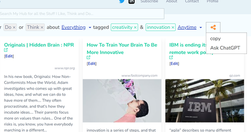
In this edition: join the ChatGPT integration free trial, check out the results of my latest experiments, and enjoy the Alliteration of the Month: Bullshit, Botshit and Bubbles.
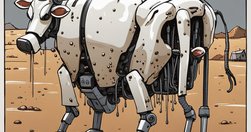
According to:MIT Professor of AI Rodney Brooks, ChatGPT "“just makes up stuff that sounds good"... where “sounds good” is an algorithm to imitate text found on the internet, while “makes up” is the basic randomness of relying on predictive text rather than logic or facts",Geoff Hinton: "the greatest risks is not that chatbots w…
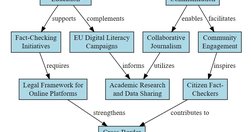
"If Charts lie, ChatGPT visualisations lie brilliantly". Exploring knowledge visualisations powered by ChatGPT, which can be particularly problematic because of the way the LLM's hallucinations - already hard to spot by their very nature - are also hidden behind the visualisation. But they have real potential as a creative muse.
Shows how to "Master web scraping without a single line of code" using the ChatGPT plugin (requires ChatGPT Plus) "scraper", and provides a prompt to extract content from a web page and arrange it in a table. And then use "plugins like “Doc Maker” or “CSV Exporter” ... or Code Interpreter for conversions."For large pr…
"I'm working with the garage door up as I learn how best to integrate AI with MyHub.ai... as anyone who has played with any LLM for any length of time knows... You need to try stuff out, compare results and try some more. You need, in other words, to experiment... Given that I am managing my research notes in Obsidian, sharing them here …
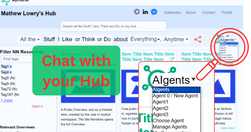
Over the summer I put the "ai" into myhub.ai and turned my Hub into a personal GPT wrapper. I've been experimenting ever since.
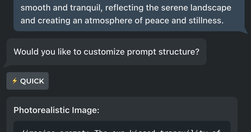
"Bring AI to your browser. Chat with websites, PDFs, videos, write emails, SEO articles, tweets, automate workflows, monitor prices & data. Bing AI & Notion AI alternative... can summarize and reply to emails for you, rewrite, rephrase, correct and expand text, read articles, translate and scan web pages for data. "I started tes…

"now you can control how ChatGPT responds in every chat by using custom instructions" - this quick runthrough of what they are, how to enable them, and some examples only scratches the surface.When using custom instructions you answer two questions:tell ChatGPT more about youtell ChatGPT how you want it to respondThe two answers should p…
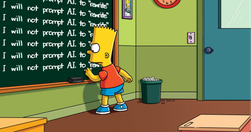
"how can you use ChatGPT to generate ideas and brainstorm within Obsidian?", which is currently my note-taking tool of choice. First, some generic advice for prompting:"be specific about the outcome that you want to achieve... providing a prompt that contains more descriptive language ...give preceding prompts ... [specify the] resp…

A (rather MS-worshipful) introduction to "Code Interpreter... game-changing plugin inside GPT-4 that simplifies data handling and analysis by using plain English ... anyone — regardless of their technical skills — can access and interpret complex information in seconds.""Several" use cases are presented, but all are in fact dat…
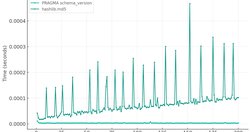
"Code Interpreter mode ... [allows] ChatGPT ... generate Python code and execute it in a restricted sandbox" - no network access, can access pre-approved libraries.

ChatGPT can be "a highly capable writing partner that never sleeps ... [if you] treat it like an editor, a proofreader, and a disgruntled reader... make it an enemy of my text and let it attack it as vigorously as possible."personal devil's advocate: ask it "to list the top three arguments that someone opposed to my thinking wo…
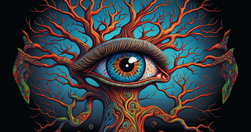
WritingGPT is an AutoGPT that "simulates an entire writing team, crafting high-quality blog posts [with] only a prompt and a target keyword... articles that provide genuine insights — and that rank on Google.""AutoGPTs are AIs talking to AIs... the output of one AI system as the input for another... chain together multiple AIs, enha…
"leverage ChatGPT to answer natural language questions on a variety of text repositories... [via a ]combination of embeddings, vector search, and prompt engineering...Embeddings are mathematical representations of words, phrases, or even entire documents as vectors ... sequences [with] similar meaning are “close together” in a high-dimensiona…
"“Document Search Chatbot” ... field common questions (FAQ’s) based on the content of several documents.... Azure Search to extract and rank key highlights from a set of text documents based on a user query. This user query and Azure Search results are then passed to OpenAI to be interpreted and formatted into a chat based response..."Wh…
A sneak peek at Miro's new AI features for ideation and innovation, including their "AI powered mindmap... mind map with AI assistance"."While ChatGPT can be a powerful tool for generating ideas... the linear nature of chat threads" clashes with ideation's nonlinear nature, & "the sheer volume of ideas genera…
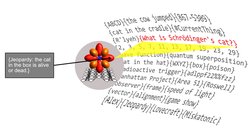
Jon Stokes thinks "people are talking about this chatbot in unhelpful ways... anthropomorphizing ... [and] not working with a practical, productive understanding of what the bot’s main parts are and how they fit together."So he wrote this explainer."At the heart of ChatGPT is a large language model (LLM) that belongs to the family o…
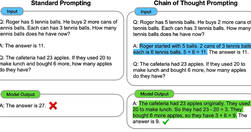
"Most of us use ChatGPT wrong. We don’t include examples in our prompts. We ignore that we can control ChatGPT’s behavior with roles. We let ChatGPT guess stuff instead of providing it with some information... We need ... high-quality prompts ... [so here's] 4 techniques used in prompt engineering."There's even a video."Fe…
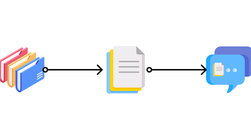
" a step-by-step guide for building a document Q&A chatbot in an efficient way with llama-index and GPT API... ask the bot in natural language about your own documents/data... [see it] retrieving info from the documents and generating a response [1]... customer support, synthesizing user research, your personal knowledge management"K…

"ChatGPT API will allow developers to integrate ChatGPT into their own applications, products, or services". Not to be confused with ChatGPT Plus:"API has its own pricing... https://openai.com/pricing.ChatGPT Plus subscription covers usage on chat.openai.com only and costs $20/month."ChatGPT API prices:"Free trial users: 2…

"You Are Not a Parrot and a chatbot is not a human" - an interview/profile of Emily M. Bender, the "computational linguist at the University of Washington ... [who] co-wrote the octopus paper... to illustrate what ... LLMs ... can and cannot do"The paper: "Climbing Towards NLU: On Meaning, Form, and Understanding in the Ag…
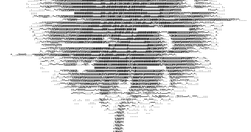
Noam Chomsky on ChatGPT, Bard and Sydney, which "take huge amounts of data, search for patterns in it and become increasingly proficient at generating statistically probable outputs — such as seemingly humanlike language and thought... hailed as the first glimmers on the horizon of artificial general intelligence ... surpassing human ... inte…

"Microsoft imagines helping clients launch new chatbots or refine their existing ones", using a version of ChatGPT trained on post-2021 content. "The service should also provide citations to specific resources... give customers ways to upload their own data and refine the voice of their chatbots... replace Microsoft and OpenAI brand…

ChatGPT-powered, the "‘My AI’ bot will ... initially only available for $3.99 a month Snapchat Plus subscribers.., eventually all... we’re going to talk to AI every day" - useful, if you're a messaging service.It's a "fast mobile-friendly version of ChatGPT inside Snapchat... trained to adhere to the company’s trust and sa…

While "Wolfram Alpha... seeks to distill scientific facts and perform calculations", ChatGPT and other similar AIs "build statistical models and string together sentences or pictures by calculating probabilities (of what the next word should be, for example). That has led to all kinds of mistakes ... Wolfram is not optimistic that t…

"What if we were to think of LLMs not as tools for answering questions, but as tools for asking us questions and inspiring our creativity? ... even simple tools can lead to interesting results when they clash with the contents of our minds"So he tries using ChatGPT as a muse. TL:DR; "ChatGPT asked me probing questions, suggested spe…
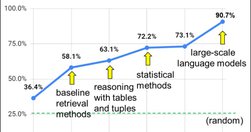
When James West "joined a small wave of users granted early access" to the new Bing (I'll call and tag it "BingGPT"), powered by the same LLM behind ChatGPT, which is "a great party trick ... powerful work tool, capable of jumpstarting creativity, automating mundane tasks", he soon "noticed strange inconsist…

Jeff Jarvis is not a fan of Ted Chiang's piece on CgatGPT, although he does admit TC (one of my favourite authors) "makes a clever comparison between lossy compression... and large-language models, which learn from and spit back but do not record the entire web". Indeed, he takes the metaphor further: "what is journalism itself…
Interesting, illuminating (but contested) metaphor for thinking about LLMs from one of my favourite authors, Ted Chiang:"Think of ChatGPT as a blurry jpeg of all the text on the Web. It retains much of the information... but, if you’re looking for an exact sequence of bits, you won’t find it; all you will ever get is an approximation... nonse…